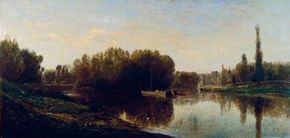Charles-François Daubigny's The Banks of the Oise (1859), was painted en plein air by which the artist achieved a fresh effect that could not be matched in the confines of a studio.
Daubigny's naturalistic approach to landscape involved painting in the open air. Prior to the early 1840s, artists composed their landscapes in the studio from sketches and from memory. Advances in lightweight easels and portable art materials allowed an artist to work outdoors and record the effects of light, shadow, and atmosphere from direct observation.
Advertisement
